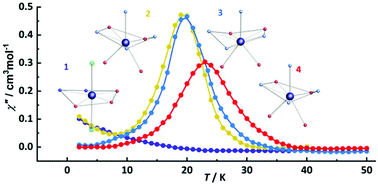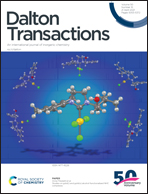A new class of DyIII-SIMs associated with a guanidine-based ligand†
Abstract
A family of four mononuclear DyIII complexes of the guanidine-based ligand L [L = tris(2-hydroxybenzylidene)triaminoguanidine] with formulas [DyLCl2(DMF)2]·DMF·CH3OH (1), [DyL2(CH3OH)2]Br·H2O·3CH3OH (2), [DyL2(H2O)2]SCN·3H2O·CH3OH (3) and [DyL2(CH3OH)2]SCN·CH3CN·CH3OH (4) were successfully prepared by varying reaction conditions. Complex 1 is seven-coordinate, with three N2O from ligand L along with two equatorially trapped DMF molecules and two axial Cl− anions, adopting pentagonal bipyramidal D5h symmetry. Complexes 2–4 have somewhat similar structures with six donor N4O2 sites from two ligands and two O from corresponding solvent molecules, featuring a N4O4 octa-coordinate environment with triangular dodecahedron D2d symmetry. Magnetic investigations indicated that complex 1 did not demonstrate single-molecule magnetic behavior, while complexes 2–4 were single-ion magnets (SIMs) under zero applied DC field with the effective energy barriers (Ueff) of 207.3 (2), 222.5 (3) and 311.7 K (4), respectively. The different types of coordinated solvent molecules and counter anions caused changes in intermolecular interactions and coordination geometries that severely affected their magnetic dynamics. The magnetic behaviors of these complexes were investigated through complete-active space self-consistent field (CASSCF) calculations with the inclusion of spin–orbit effects. Calculations revealed that the measured differences in magnetic behaviors originated mainly from intermolecular and crystal-packing effects as isolated complexes 1–4 have almost identical electronic and magnetic properties.

- This article is part of the themed collection: Spotlight Collection: Lanthanide and transition metal complexes as molecular magnets


 Please wait while we load your content...
Please wait while we load your content...